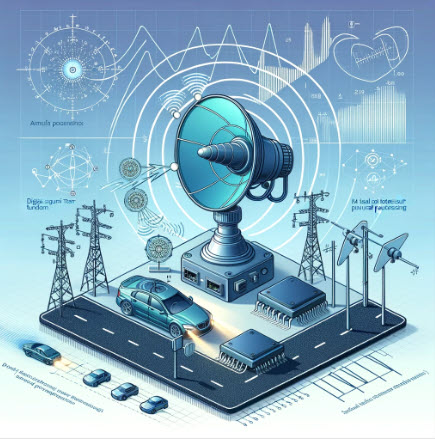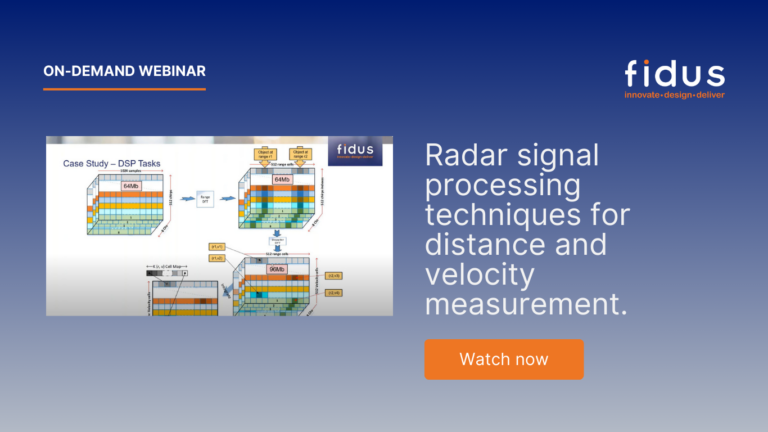Back to top

Learn How to Master Radar Signal Processing: Techniques for Distance and Velocity Measurement
WEBINAR RECORDING ON-DEMAND
This video provides an in-depth look at radar signal processing, covering the design, operation, and mathematical principles of radar systems for measuring distance and velocity. It covers the basics of radar structure, including the transmitter, receiver, and DSP unit, and explains chirp generation, repetition, and the use of signal processing to determine range, velocity, and angle of arrival. The video also explores the use of FFT for signal analysis and discusses design considerations for accurate measurements.
- Speaker: Bachir Berkane, R&D Engineer, Fidus Systems
- Date Published: January 19, 2024
- Duration: 55 Minutes
Key Insights

- DSP and FPGA in Radar Systems: The digital signal processing (DSP) part, often executed on Field-Programmable Gate Arrays (FPGAs), is crucial for handling the computationally intensive tasks of radar signal processing.
- Chirp Generation for Velocity Measurement: Chirps, or signals with frequency sweeps, are essential for measuring velocity. The process involves emitting these chirps multiple times and analyzing the reflected signals.
- Distance and Velocity Measurement: Distance measurement relies on the time delay between the transmitted and received chirps, while velocity measurement examines the phase change between consecutive chirps reflected from moving targets.
- Application of FFT: Fast Fourier Transform (FFT) is used to analyze the frequency content of the received signals, aiding in the precise calculation of distance and velocity.
- Angle of Arrival Measurement: This technique requires multiple antennas to determine the direction from which the signal arrives, based on the phase difference of signals received by different antennas.
- Case Study on System Design: A practical case study from Fidus’ own portfolio of customer work highlights the importance of system design choices, such as sampling rate and bit resolution, in achieving desired measurement accuracies.
Additional Resources

- Learn more about Fidus’ experience with signal integrity here
- Stay informed about upcoming webinars in our Thought Leadership Series by joining our upcoming webinars. Visit our webinar series page for more information and registration details.
- DSP and FPGA in Radar: Look for articles on sites like IEEE Xplore or ScienceDirect for detailed technical papers on the use of DSP and FPGA in radar systems.
- Chirp Signals: This post offers insights into the physics and mathematics behind chirp signals and their applications.
- FFT in Signal Processing: This post goes into great detail around FFT and its significance in signal processing.
- Radar System Design: For comprehensive guides on radar system design, including angle of arrival measurement, the Radar Tutorial site can be a valuable resource.
Webinar Transcript

In this technical discussion, we delve into the computational aspects of radar signal processing, particularly focusing on the Digital Signal Processing (DSP) and the role of Field-Programmable Gate Arrays (FPGAs) in managing the computationally intensive tasks.
The foundational structure of a radar system includes both a transmitter and a receiver. Our setup particularly considers a configuration with one transmit antenna and multiple receive antennas. At the core of the system is an oscillator tasked with generating a chirp—a signal with a frequency that varies over time. This chirp is essential for measuring velocity, as it needs to be emitted repeatedly, a concept we will elaborate on later.
As the chirp propagates, it splits into two paths. One path radiates freely into space, while the other is directed towards the receiver, entering through a mixer. This dual-path approach enables the radar to detect objects, such as a vehicle moving at velocity V and located at range R, with an angle of arrival θ. The received signals, weakened by distance, are then amplified and mixed to generate a beat frequency, which is subsequently digitized and processed to extract valuable data about the target’s distance and velocity.
We advance to a deeper examination of how distance measurement is achieved. By analyzing the time delay of the received chirp compared to the transmitted chirp, and applying the principles of chirp modulation, we can derive a formula that relates the beat frequency to the target’s range. This relationship is linear and is further refined through Fast Fourier Transform (FFT) to determine the precise range of the target.
Velocity measurement follows a similar principle but focuses on the phase change between consecutive chirps reflected off a moving target. By analyzing these phase changes, we can deduce the target’s velocity using Doppler FFT. This process requires careful consideration of the sampling frequency and the FFT’s resolution to ensure accurate velocity detection.
The discussion also covers the concept of angle of arrival, which necessitates the use of multiple antennas to pinpoint the direction from which the signal arrives. This technique involves comparing the phase difference of signals received by different antennas, allowing for the determination of the target’s direction.
The webinar then shifts to the practical aspects of implementing these principles in a radar system. We explore a case study of a short-range radar designed for specific operational requirements, including the sampling rate, bit resolution, and the number of chirps per frame. This segment emphasizes the importance of system design choices in achieving desired measurement accuracies and resolutions.
In summary, the main topics covered include:
- The integral role of FPGAs in handling DSP tasks within radar systems.
- The generation and significance of chirps in measuring distance and velocity.
- Mathematical foundations for calculating range and velocity from radar signals.
- The application of FFT in analyzing radar signal frequencies for distance and velocity determination.
- Techniques for enhancing the accuracy and resolution of radar measurements, including considerations for system design and signal processing algorithms.